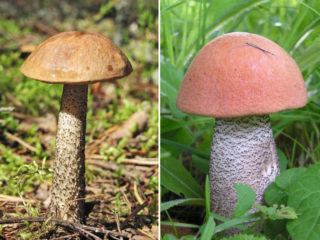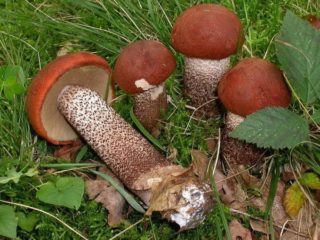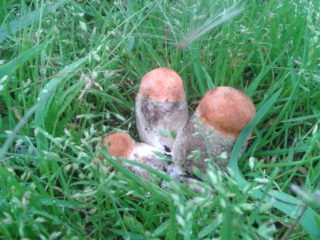Content
The pine boletus is a representative of the Boletaceae family, the genus Obabok. Typically found in mixed and deciduous forests. Very similar to other relatives of this family. However, there are also distinctive features.
What do pine boletuses look like?

At the slightest touch, the pine boletus can change its color
At a young age, the cap has a hemispherical shape; as it matures, it becomes flat-convex. The skin is velvety, dry, colored brown. The diameter of the cap varies from 7 to 15 cm, but under favorable conditions its size can be larger.
The leg is cylindrical, thickened at the base, solid. It reaches a length of up to 15 cm, and a thickness of up to 5 cm in diameter. It is painted white; there may be a greenish tint at the base. The pulp is dense without a pronounced smell or taste. The hymenophore consists of a tubular layer, which at the initial stage of maturation is colored white, and at an older age acquires a grayish-cream tone. Turns red when pressed. The spore powder has a yellow-brown tint.
Where do pine boletuses grow?
The favorable time for the development of this species is the period from June to October. Pine boletuses grow in areas characterized by a temperate climate. Most often they live in coniferous and mixed forests, forming mycorrhizae exclusively with pine trees.
Is it possible to eat pine boletuses?
Pine boletus is one of the edible mushrooms. Suitable for any type of processing, so they can be fried, boiled, frozen, salted, dried and pickled. During cooking, it acquires a darker shade, which is characteristic of these mushrooms.
False twins of pine boletuses

Mushrooms tend to accumulate toxins, so experts do not recommend collecting overripe fruits.
The specimen in question has external similarities with many species of boletus. The most striking twins are:
- The yellow-brown boletus belongs to the edible category.The cap of this variety has more saturated orange tones, and forms mycorrhizae exclusively with birch. Another distinctive feature is that when cut, the mushroom acquires a pink tint, and after a while it turns blue or green.
Yellow-brown boletus is found in the same climatic zone as pine
- Spruce boletus is an edible mushroom that forms mycorrhiza only with spruce trees. Unlike the species in question, the double has a slight roughness on its cap.
This specimen prefers to grow in pine or spruce forests next to berries or mosses
- Oak boletus. The main differences are the browner shades of the fruiting body and the stem with red scaly growths.
Pine boletus is an edible mushroom that grows near oak trees
- White boletus. Most similar to the specimen in question in adulthood. At the ripening stage, the cap is painted white, and after some time it acquires brown shades.
In adulthood, the cap of this species always turns from white to yellowish or brown
- Red boletus is an edible specimen. You can distinguish it from pine by the crimson color of the cap.
As a rule, red boletus forms mycorrhiza with aspens, in some cases it grows close to other deciduous trees
- The gall mushroom is the only inedible species among its counterparts. Distinctive features include a darker brown cap and a slightly curved stem.
The second name of this mushroom is bitter, which it received because of its unpleasant bitter taste.
Collection rules
When going in search of pine boletuses, you should head for mixed and deciduous forests. Also, do not forget that this species forms mycorrhiza only with pine trees. Each specimen should be carefully cut with a knife so as not to damage the mycelium. After collection, primary processing should be carried out as quickly as possible, since pine boletuses deteriorate quite quickly. You should not add rotten specimens to the general basket, as there is a high probability of poisoning from them. It is also not recommended to collect old forest products due to the inherent unpleasant taste.
Use
There is quite a wide variety of recipes using this ingredient. It was previously mentioned that pine boletuses are suitable for all types of processing. It is believed that they are especially good fried or boiled as a main dish. However, before proceeding to cooking, it is necessary to carry out pre-processing. To do this, the gifts of the forest are washed and cleared of twigs, leaves and other debris. Many experienced cooks recommend leaving them in salted water for an hour before cooking. To prevent the mushrooms from darkening during heat treatment, you can add a small amount of citric acid to the soaking solution. When drying, on the contrary, experts do not recommend washing them, much less soaking them, since otherwise the process will drag on for a long time.
Conclusion
Pine boletus is not only edible, but also a tasty mushroom, which is used to prepare various dishes.Despite this, it should be remembered that including this product in the diet is quite dangerous for children, pregnant and lactating women, as well as people prone to allergies or suffering from chronic pathologies of the digestive system.














